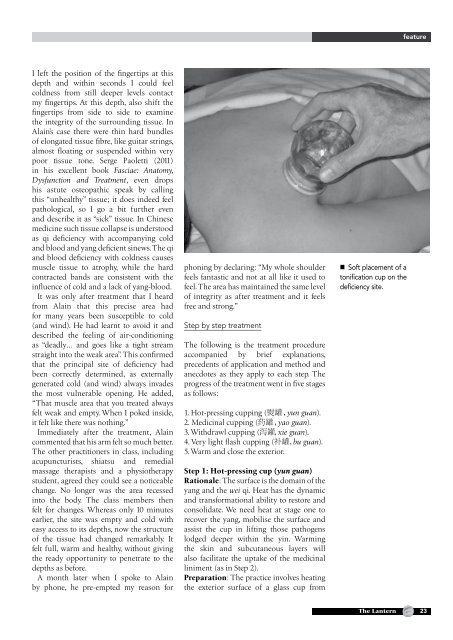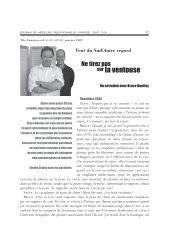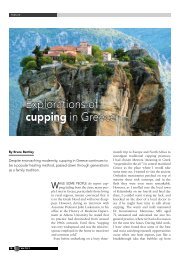Cupping Deficiency - Australian School of Traditional Thai Massage
Cupping Deficiency - Australian School of Traditional Thai Massage
Cupping Deficiency - Australian School of Traditional Thai Massage
Create successful ePaper yourself
Turn your PDF publications into a flip-book with our unique Google optimized e-Paper software.
I left the position <strong>of</strong> the fingertips at this<br />
depth and within seconds I could feel<br />
coldness from still deeper levels contact<br />
my fingertips. At this depth, also shift the<br />
fingertips from side to side to examine<br />
the integrity <strong>of</strong> the surrounding tissue. In<br />
Alain’s case there were thin hard bundles<br />
<strong>of</strong> elongated tissue fibre, like guitar strings,<br />
almost floating or suspended within very<br />
poor tissue tone. Serge Paoletti (2011)<br />
in his excellent book Fasciae: Anatomy,<br />
Dysfunction and Treatment, even drops<br />
his astute osteopathic speak by calling<br />
this “unhealthy” tissue; it does indeed feel<br />
pathological, so I go a bit further even<br />
and describe it as “sick” tissue. In Chinese<br />
medicine such tissue collapse is understood<br />
as qi deficiency with accompanying cold<br />
and blood and yang deficient sinews. The qi<br />
and blood deficiency with coldness causes<br />
muscle tissue to atrophy, while the hard<br />
contracted bands are consistent with the<br />
influence <strong>of</strong> cold and a lack <strong>of</strong> yang-blood.<br />
It was only after treatment that I heard<br />
from Alain that this precise area had<br />
for many years been susceptible to cold<br />
(and wind). He had learnt to avoid it and<br />
described the feeling <strong>of</strong> air-conditioning<br />
as “deadly… and goes like a tight stream<br />
straight into the weak area”. This confirmed<br />
that the principal site <strong>of</strong> deficiency had<br />
been correctly determined, as externally<br />
generated cold (and wind) always invades<br />
the most vulnerable opening. He added,<br />
“That muscle area that you treated always<br />
felt weak and empty. When I poked inside,<br />
it felt like there was nothing.”<br />
Immediately after the treatment, Alain<br />
commented that his arm felt so much better.<br />
The other practitioners in class, including<br />
acupuncturists, shiatsu and remedial<br />
massage therapists and a physiotherapy<br />
student, agreed they could see a noticeable<br />
change. No longer was the area recessed<br />
into the body. The class members then<br />
felt for changes. Whereas only 10 minutes<br />
earlier, the site was empty and cold with<br />
easy access to its depths, now the structure<br />
<strong>of</strong> the tissue had changed remarkably. It<br />
felt full, warm and healthy, without giving<br />
the ready opportunity to penetrate to the<br />
depths as before.<br />
A month later when I spoke to Alain<br />
by phone, he pre-empted my reason for<br />
phoning by declaring: “My whole shoulder<br />
feels fantastic and not at all like it used to<br />
feel. The area has maintained the same level<br />
<strong>of</strong> integrity as after treatment and it feels<br />
free and strong.”<br />
Step by step treatment<br />
The following is the treatment procedure<br />
accompanied by brief explanations,<br />
precedents <strong>of</strong> application and method and<br />
anecdotes as they apply to each step. The<br />
progress <strong>of</strong> the treatment went in five stages<br />
as follows:<br />
1. Hot-pressing cupping ( yun guan).<br />
2. Medicinal cupping ( yao guan).<br />
3. Withdrawl cupping ( xie guan).<br />
4. Very light flash cupping ( bu guan).<br />
5. Warm and close the exterior.<br />
Step 1: Hot-pressing cup (yun guan)<br />
Rationale: The surface is the domain <strong>of</strong> the<br />
yang and the wei qi. Heat has the dynamic<br />
and transformational ability to restore and<br />
consolidate. We need heat at stage one to<br />
recover the yang, mobilise the surface and<br />
assist the cup in lifting those pathogens<br />
lodged deeper within the yin. Warming<br />
the skin and subcutaneous layers will<br />
also facilitate the uptake <strong>of</strong> the medicinal<br />
liniment (as in Step 2).<br />
Preparation: The practice involves heating<br />
the exterior surface <strong>of</strong> a glass cup from<br />
n S<strong>of</strong>t placement <strong>of</strong> a<br />
tonification cup on the<br />
deficiency site.<br />
feature<br />
The Lantern 23




